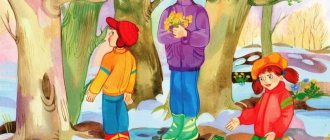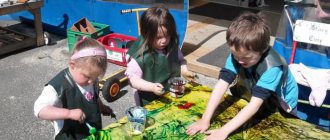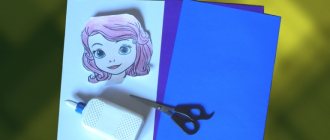Educational educational video for children about how animals live in spring
In the video, children aged 5-10 years will see floods in the forest, wolves on the hunt, a bear crawling out of its den, and many other spring phenomena in nature. This film was made at a studio of educational films for children and is structured as a dialogue between a child and an adult. The child watches the animals and asks the adult questions, the adult answers his questions and gives interesting additional information. Watch a movie with your kids. The film is of very high quality and made professionally, taking into account all the requirements for educational films for children. Enjoy watching and new discoveries!
For the curious: about forest babies and their mothers. Interesting information about animals in spring
Hares in spring
Mom is a hare
feeds the bunnies and immediately runs away, leaving them alone under a bush. And the bunnies sit under the bush for three to four days, waiting for their new mother, the hare, to feed them.
There are no strangers' bunnies - they are all their own and will always be fed. Hares' milk is fatty and nutritious; it lasts for 3-4 days.
Why does nature work this way? The fact is that hares have sweat and sebaceous glands only on the soles of their paws. And if the hare lived with the hares, they would quickly be found - smelled by the smell - a fox or a wolf. After all, rabbits have many enemies - fox, wolf, marten, lynx, and birds of prey. And when a tiny bunny sits under a bush and hides its paws under itself, it is impossible to find it by its smell. It turns out that by running away from the bunnies, the hare saves them.
After 8-9 days, the rabbits will have teeth, and then grass will appear, and they will begin to feed themselves.
Squirrels in spring
At the squirrel's
Baby squirrels also appear in the spring. They are born naked, helpless, and cannot see anything. The mother squirrel takes care of them, feeding the squirrels milk for two months. But dad, the squirrel, doesn’t live with his family, he lives separately.
The mother squirrel spends a lot of time searching for food, otherwise the baby squirrels will grow up frail and sick. Baby squirrels require special attention from the mother squirrel; they need to be covered, warmed, and fed. Only after a month do the baby squirrels open their eyes and begin to look out of the nest.
In spring, the squirrel is the enemy of all birds and the most dangerous predator for many birds. She destroys bird nests on tree branches and steals chicks and eggs from them.
Hedgehogs in spring
In April, hedgehogs also appear. They are born in a hedgehog's nest, which looks like a hut made of dry leaves, twigs and moss. The hedgehog feeds the hedgehogs with milk and takes care of them.
Hedgehogs, like baby squirrels, are born helpless and naked, without needles. A few hours after birth, bumps appear on the skin of the hedgehogs, then they burst, and thin needles appear from them. Then the needles will harden and turn into thorns. The mother of the hedgehog first feeds the hedgehogs with milk, and then, when they grow up, she brings them earthworms and slugs to their nest.
Bears in the spring
In April, a mother bear with grown cubs wakes up and leaves the den. She wanders through the forest - looking for food: pulling out bulbs and roots of plants, looking for larvae.
Coming out of the den, the bear stretches, rolls around, tries to warm up after hibernation, and puts his fur coat in order. And looking for food.
By the time they leave the den, bears molt. They lose their thick winter coat and grow a short, darker coat. The fur will grow again all summer and will be thick and warm by the new winter (bears do not shed in the fall).
In the spring, the she-bear not only feeds the cubs with her milk, but also teaches them to get their own food - dig roots out of the ground, look for insects, last year's berries. Even if the mother bear is hungry, first of all she will give food to her babies - the cubs. While protecting the cubs, the mother bear can attack any enemy.
In the spring, the mother bear bathes her cubs in streams and lakes: she takes them by the scruff of the neck and lowers them into the water. Later, when the kids grow up, they will begin to bathe themselves.
Creative task “Unwashed Raccoon”.
Read to the children a wonderful fairy tale about the Raccoon. And together with your child, figure out how this story ends.
E. Shim “Who looks like whom?”
“Little Raccoon ran home, and his mother gasped:
- Fathers, who do you look like?! Where have you been messing around? Why is all the fur in the trash?
- And I was stirring up an anthill.
- Why are your paws covered in swamp mud?
- And I was chasing a frog.
- Why is your nose in the ground?!
- I dug up a beetle...
- No, just look at him! - mom says. – Is this what decent animals look like?
What do decent animals look like?
- Decent animals have shiny fur, licked noses, cleaned claws! And look at yourself!
“I wanted to take a look,” Raccoon replies, “but they didn’t let me.”
- Who didn’t?
- And the Bear. I didn’t come to the river, I went down to the water - suddenly there was a Mother Bear with her cubs! So scary! I'm angry!
- Do you know why she came to the river?
- Don't know. I quickly ran away.
“She brought the cubs to bathe them.” And she is ashamed when the children are grimy!
“That’s it...” says Raccoon. - Now understand. Otherwise, I couldn’t guess why she was waving her paw and growling: “Oh, you little freak, oh you unwashed Raccoon!”
Questions for children:
- Why couldn’t Raccoon look at himself – at his reflection in the water?
- Why did the Bear come to the river? Why did the Bear growl and get angry?
- What did the Raccoon do next when he found out why the Bear was angry and cursed “The Raccoon is unwashed”?
- Together with your children, figure out how this story ends. (For example, Raccoon quickly ran to the river, washed his face, combed his hair, cleaned his claws. He returned home, even his mother did not recognize him, and was very happy...)
Sometimes in a family of bears there is an older bear cub - a “pestun” (a bear cub from last year’s litter). So it is called from the word “nurture”. The bear cub is a nurse - the main assistant of the mother - bear, a role model for kids - bear cubs. He shows them how to climb hollows for honey, how to feast on ants and their larvae. He separates the cubs if they fight and restores order among them. This is the kind of helper the bear has! And daddy bear does not take part in raising the cubs.
The bear cub is a nurturer, although he is an older bear cub, but he loves to play. Read to your child the dialogue between the Magpie and the Teddy Bear:
E. Shim “The Magpie and the Little Bear”
“- Teddy bear, are you going to break this rowan tree?
- Nope.
-Are you bending it into an arc?
- Nope.
- Do you want to rip her off?
- Leave me alone, Soroka. I do not want anything. I just took it and am swinging on this mountain ash. Let me play at least a little before my mother comes and makes my little brother babysit!”
Foxes in spring
Foxes also have cubs. Usually in March - April, a fox gives birth to 4-6 cubs. Little foxes are dark brown in color, and the tips of their tails are white! After 3-4 weeks, the fox cubs stop eating the milk of their mother, the fox, but still live in the hole. Their parents bring them food into the hole.
Their mother, the fox, does not allow anyone near the fox cubs. She guards the hole. The mother fox watches closely to see if there is any danger nearby. In case of danger, the fox barks loudly, and the cubs quickly run away - they hide deep in the hole. And if people or dogs have visited the fox hole, then the fox will definitely move her cubs to another safe place - away from the previous hole. The father fox also helps raise the fox cubs. He teaches them and brings them booty.
Wolves in the spring
To raise wolf cubs, wolves make a den in the forest thicket. In the spring, a she-wolf gives birth to 4-7 cubs. They are born helpless and covered with gray fluff. First, the she-wolf feeds the cubs with her milk, and does not leave them anywhere. And daddy the wolf brings food to the she-wolf. When the wolf cubs grow up, both mother and father feed them together.
Moose in spring
In the spring, a moose cow gives birth to 1-2 calves. The mother moose licks them after birth, and they immediately stand on their legs. And after 3-4 days, little elk calves run after their mother! Their mother, the moose cow, feeds them with her milk for a long time, and the moose calves grow like heroes - by leaps and bounds!
Badgers in the spring
The badger wakes up and crawls out of the hole. The badger is a very neat and clean animal. Therefore, in the spring he begins to repair his house, renews his bedding, cleans the passages, and throws out the garbage.
In the spring, the badger eats everything edible it can find, as it needs to quickly restore strength after hibernation. It eats larvae, earthworms, mice, and destroys bird nests.
In April, a badger gives birth to 3-6 badger cubs. She raises them alone. For several days she does not leave the hole at all, then she comes out, but not for long. To make the babies grow faster, the badger takes them one by one out into the sunshine into the fresh air - she takes them in her teeth, brings them and places them side by side under a bush or under a tree. When the badger cubs are two months old, they come out of the hole on their own.
Pisces in the spring
In the spring, the ice on the river melts and it is no longer possible to walk on it. And then the ice begins to drift completely. All the inhabitants of the reservoirs are happy that it has become light under the water. The fish swim to shallow places where the water is more warmed by the sun.
In spring, fish begin to grow, and their scales grow in rings. And by their number you can determine how old the fish is.
In May, fish spawn. The fry emerge from it.
At first the fry are naked, without scales, then they grow scales. First of all, the pectoral fins of the future fish grow, then the fins on the back, and then on the stomach. When the fry grow up, it develops a tail.
The fry hide from their enemies in the darkness. In some fish, the fry hide in their parents' mouths and sit there in safety. Sometimes the fry hide next to their parents, clinging to their side and swimming away from the dangerous place.





